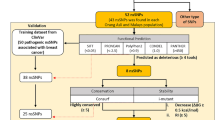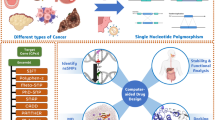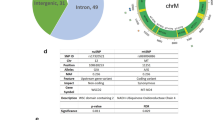Abstract
Single-nucleotide polymorphisms (SNPs) contributing to interactions between regulatory elements that modulate gene transcription may explain some of the uncharacterized variation for complex traits. We explored this hypothesis among 856 adult survivors of pediatric cancer exposed to curative treatments that adversely affect bone mineral density (BMD). To restrict our search to interactions among SNPs in regulatory elements, our analysis considered 75523 SNPs mapped to putative promoter or enhancer regions. In anticipation that power to detect higher order epistasis would be low using an exhaustive search and a Bonferroni-corrected threshold for genome-wide significance (e.g., P < 5.6 × 10−14), a novel non-exhaustive statistical algorithm was implemented to detect chromosome-wide three-way regulatory interactions. We used a permutation-based evaluation statistic to identify candidate SNP interactions with stronger associations with BMD than expected. Of the six regulatory 3-SNP interactions identified as candidate interactions (P < 3.5 × 10−11) among cancer survivors exposed to treatments, five were replicated in an independent cohort of survivors (N = 1428) as modifiers of treatment effects on BMD (P < 0.05). Analyses with publicly available bioinformatics data revealed that SNPs contributing to replicated interactions were enriched for gene expressions (P = 3.6 × 10−4) and enhancer states (P < 0.05) in cells relevant for bone biology. For each replicated interaction, implicated SNPs were within or directly adjacent to 100-kb windows of genomic regions that plausibly physically interact in lymphoblastoid cells. Our study demonstrates the utility of a hypothesis-driven approach in revealing epistasis associated with complex traits.
Similar content being viewed by others
Log in or create a free account to read this content
Gain free access to this article, as well as selected content from this journal and more on nature.com
or
References
Gurney JG, Kaste SC, Liu W, et al. Bone mineral density among long-term survivors of childhood acute lymphoblastic leukemia: results from the St. Jude Lifetime Cohort Study. Pediatr Blood Cancer. 2014;61:1270–6.
Wasilewski-Masker K, Kaste SC, Hudson MM, Esiashvili N, Mattano LA, Meacham LR. Bone mineral density deficits in survivors of childhood cancer: long-term follow-up guidelines and review of the literature. Pediatrics. 2008;121:e705–13.
Kaste SC, Rai SN, Fleming K, et al. Changes in bone mineral density in survivors of childhood acute lymphoblastic leukemia. Pediatr Blood Cancer. 2006;46:77–87.
Kumar J, Swanberg M, McGuigan F, Callreus M, Gerdhem P, Åkesson K. LRP4 association to bone properties and fracture and interaction with genes in the Wnt-and BMP signaling pathways. Bone. 2011;49:343–8.
Yang TL, Guo Y, Li J, et al. Gene‐gene interaction between RBMS3 and ZNF516 influences bone mineral density. J Bone Miner Res. 2013;28:828–37.
Seeman E. Pathogenesis of bone fragility in women and men. Lancet. 2002;359:1841–50.
Takayanagi H. Osteoimmunology: shared mechanisms and crosstalk between the immune and bone systems. Nat Rev Immunol. 2007;7:292.
Hemani G, Shakhbazov K, Westra HJ, et al. Detection and replication of epistasis influencing transcription in humans. Nature. 2014;508:249–53.
Dinu I, Mahasirimongkol S, Liu Q, et al. SNP-SNP interactions discovered by logic regression explain Crohn’s disease genetics. PLoS ONE. 2012;7:e43035.
Emily M, Mailund T, Hein J, Schauser L, Schierup MH. Using biological networks to search for interacting loci in genome-wide association studies. Eur J Hum Genet. 2009;17:1231–40.
Wei W-H, Hemani G, Gyenesei A, et al. Genome-wide analysis of epistasis in body mass index using multiple human populations. Eur J Hum Genet. 2012;20:857–62.
Dekker J, Marti-Renom MA, Mirny LA. Exploring the three-dimensional organization of genomes: interpreting chromatin interaction data. Nat Rev Genet. 2013;14:390–403.
Visel A, Rubin EM, Pennacchio LA. Genomic views of distant-acting enhancers. Nature. 2009;461:199–205.
Ernst J, Kheradpour P, Mikkelsen TS, et al. Mapping and analysis of chromatin state dynamics in nine human cell types. Nature. 2011;473:43–9.
Hudson MM, Ness KK, Nolan VG, et al. Prospective medical assessment of adults surviving childhood cancer: study design, cohort characteristics, and feasibility of the St. Jude Lifetime Cohort study. Pediatr Blood Cancer. 2011;56:825–36.
Pritchard JK, Stephens M, Donnelly P. Inference of population structure using multilocus genotype data. Genetics. 2000;155:945–59.
Browning SR, Browning BL. Rapid and accurate haplotype phasing and missing-data inference for whole-genome association studies by use of localized haplotype clustering. Am J Hum Genet. 2007;81:1084–97.
Ruczinski I, Kooperberg C, LeBlanc M. Logic regression. J Comp Graph Stat. 2003;12:475–511.
Tusher VG, Tibshirani R, Chu G. Significance analysis of microarrays applied to the ionizing radiation response. Proc Natl Acad Sci Usa. 2001;98:5116–21.
Wei W-H, Hemani G, Haley CS. Detecting epistasis in human complex traits. Nat Rev Genet. 2014;15:722–33.
GTEx Consortium. Human genomics. The Genotype-Tissue Expression (GTEx) pilot analysis: multitissue gene regulation in humans. Science. 2015;348:648–60.
Zeller T, Wild P, Szymczak S, et al. Genetics and beyond–the transcriptome of human monocytes and disease susceptibility. PLoS ONE. 2010;5:e10693.
Kundaje A, Meuleman W, Ernst J, et al. Integrative analysis of 111 reference human epigenomes. Nature. 2015;518:317–30.
Lieberman-Aiden E, Van Berkum NL, Williams L, et al. Comprehensive mapping of long-range interactions reveals folding principles of the human genome. Science. 2009;326:289–93.
Zhou X, Lowdon RF, Li D, et al. Exploring long-range genome interactions using the WashU Epigenome Browser. Nat Methods. 2013;10:375–6.
ENCODE Project Consortium. An integrated encyclopedia of DNA elements in the human genome. Nature. 2012;489:57–74.
Timpson NJ, Tobias JH, Richards JB, et al. Common variants in the region around Osterix are associated with bone mineral density and growth in childhood. Hum Mol Genet. 2009;18:1510–7.
Estrada K, Styrkarsdottir U, Evangelou E, et al. Genome-wide meta-analysis identifies 56 bone mineral density loci and reveals 14 loci associated with risk of fracture. Nat Genet. 2012;44:491–501.
Nakashima K, Zhou X, Kunkel G, et al. The novel zinc finger-containing transcription factor osterix is required for osteoblast differentiation and bone formation. Cell. 2002;108:17–29.
Georgiou KR, Scherer MA, Fan CM, et al. Methotrexate chemotherapy reduces osteogenesis but increases adipogenic potential in the bone marrow. J Cell Physiol. 2012;227:909–18.
Acknowledgements
This project was funded and supported by the St. Jude Lifetime Cohort Study (U01 CA195547), American Lebanese Syrian Associated Charities, Rally Foundation for Childhood Cancer Research, National Institutes of Health Grant R01CA216354, and Alberta Machine Intelligence Institute.
Author contributions
Conceived and designed SJLIFE study: KKN, SCK, WC, MMH, LLR, CLW. Conceived and designed analytic methodologies and performed the analysis: CI, YY. Managed data: CI, WM, YS, RJB, CLW. Drafted the paper: CI, YY, CLW. Critical revision and final approval of the paper: All authors.
Author information
Authors and Affiliations
Corresponding author
Ethics declarations
Conflict of interest
The authors declare that they have no conflict of interest.
Additional information
Publisher's note: Springer Nature remains neutral with regard to jurisdictional claims in published maps and institutional affiliations.
Yutaka Yasui and Carmen L. Wilson contributed equally to this work
Electronic supplementary material
Rights and permissions
About this article
Cite this article
Im, C., Ness, K.K., Kaste, S.C. et al. Genome-wide search for higher order epistasis as modifiers of treatment effects on bone mineral density in childhood cancer survivors. Eur J Hum Genet 26, 275–286 (2018). https://doi.org/10.1038/s41431-017-0050-x
Received:
Revised:
Accepted:
Published:
Issue date:
DOI: https://doi.org/10.1038/s41431-017-0050-x
This article is cited by
-
Genome-wide haplotype association analysis of primary biliary cholangitis risk in Japanese
Scientific Reports (2018)



